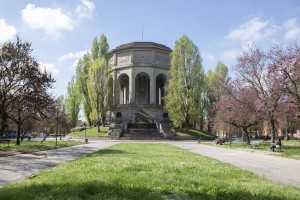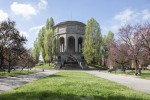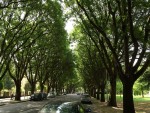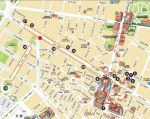Corso Vittorio Veneto
Corso Vittorio Veneto is one of the most scenic thoroughfares in Ferrara. Shaded by trees, it unites Viale Cavour with Piazza XXIV Maggio, at the centre of which is the monumental aqueduct.
History
Corso Vittorio Veneto and, more generally, Piazza XXIV Maggio is found in the area that up until 1859 was occupied by the Fortezza Pontificia (Papal Fortress). The old fortress itself was built on pre-existing buildings from the House of Este era, demolished to reaffirm the sovereignty of the Papal State following the devolution in 1598. Viewed by locals as a symbol of oppression, it was torn down once the Papal State fell from power. The remains of the fortress were reused to build new structures, creating the Spianata (esplanade) in its place.
In the early twentieth century, a popular petition presented a request to redevelop the zone, a task that was entrusted to Ciro Contini in 1911. The engineer and urban planner began the area's transformation into a garden district, which would give the quarter it's present-day name (Giardino), presenting his ideas in the City Redevelopment and Expansion Plan (1911-13), which wasn’t entirely accepted. For this reason, and because of the outbreak of WWI, the redevelopment plan was taken up again in 1926, modified by municipal technicians.
The aqueduct now stands where the Fortezza Pontificia (Pontifical Fortress) once was. It was designed by Carlo Savonuzzi and built between 1930 and 1932, thanks in part to the efforts of Enrico Alessandri, the municipal draughtsman.
The name Corso Vittorio Veneto was chosen in the 1930s, i.e. at the time of its construction, demonstrating a clear link to Fascist ideology and propaganda. It is a clear reference to the battle of the same name (also called the Third Battle of the Piave) which took place on 4 November 1918, marking Italy's definitive victory over the Austro-Hungarian Empire. The same is true of many of the place names in this area, including Viale IV Novembre, Corso Isonzo, Corso Piave and Via Fiume. In the 1920s, the square where the aqueduct now stands was called Piazza XXVIII Ottobre, a reference to the march on Rome organised by the National Fascist Party under the guidance of Benito Mussolini in 1922. To further demonstrate the link to the Fascist party, it’s interesting to note that the current name was given on 13 July 1943: even at the height of WWII, place names continued to be a tool of propaganda. The name was then changed to Piazza XXIV Maggio, in reference to the day Italy entered World War I (1915).
Building description
Even if it isn’t a main road axis for Ferrara, Corso Vittorio Veneto is one of the most expansive avenues in the city. This is due to its size, which is considerable in the local context while also proportionate to its length, and the three-way division into a two-lane central axis and two side roads, each one-lane. The central axis is marked at the sides by respective rows of poplar trees, extending almost for the entire length of the avenue.
The greenery continues and expands at Piazza XXIV Maggio. There, numerous trees and shrubs mark the perimeter and also enrich the park around the aqueduct at the centre of the square and in perfect perspective with Corso Vittorio Veneto. The resulting effect is quite spectacular.
Context and surroundings
Corso Vittorio Veneto is the main road in the area that was redefined in the early twentieth century by the urban planning and requalification project launched in the 1910s by Ciro Contini (Ferrara, 25 February 1873 - Los Angeles, 1952) according to modern principles. The very name of the quarter, Giardino (‘garden’ in Italian), reflects his plans for a garden district in the part of Ferrara once occupied by Castel Tedaldo and its delizia (rural villa), which, during the time of the House of Este, stood on Belvedere Island in the River Po. After the devolution of the Este family, the Fortezza Pontificia (the papal fortress - a parade ground with warehouses and other structures) was built on the site. In the late nineteenth century, it was demolished to make way for what eventually became the Spianata (a flat clearing). With the urban renewal of the early twentieth century, it led to the conception and start of that which Carlo Bassi called the Contini Addition (Ferrara Rara. Perché Ferrara è bella, Cernobbio, Archivio Cattaneo editore in Cernobbio, 2015, p. 42).
This involved the tearing down of the nearby city walls and the creation of a large green area, implemented in the early twentieth century. However, the project was interrupted by WWI.
Thanks to Balbo and Chief Magistrate Ravenna, work began again after 1926, with modifications to the Contini plan. The result is what we see today: the (fortunately) only partial destruction of the city walls and the creation of Corso Vittorio Veneto, characterised by stately houses and the monumental reservoir of the aqueduct, as well as the ‘Paolo Mazza’ Stadium, designed by Carlo Savonuzzi and inaugurated on 20 September 1928. The city’s main examples of Italian art nouveau and neo-Estense architecture can be found in this quarter and its surroundings, embodying the Fascist government's attempt to graft new aesthetic ideals onto the traditional local architecture that defines the look of Ferrara.
It is only a part of what is known as the Fascist Addition (C. Bassi, p. 43), which covers other parts of the city. This widespread architectural and urban planning campaign included the reorganisation of roads, sewers and public lighting, and combined the restoration of existing buildings with the creation of new ones inspired by rationalist principles, while maintaining continuity with local traditions. These efforts lasted throughout the Fascist era and beyond, with some buildings completed in the post-war period. Due to the complexity and diachronic extension of the plan, it is often more correctly referred to as the Addizione Novecentista (Twentieth-century Addition).
Corso Vittorio Veneto connects Viale Cavour and Piazza XXIV, at its widest after the gardens that face Via Poledrelli, at the corner of the eponymous school.
It is just a few hundred meters from the station, the old town, and even from numerous early twentieth-century buildings such as Art Nouveau houses, Palazzo Panfilio, Palazzo dell’Aeronautica, the former Casa del Fascio and the Poledrelli School, which marks the beginning of the Corso.
Note
Card text by Barbara Pizzo
Sitography
Related places
Related Themes
Related Itineraries
Compiling entity
- Assessorato alla Cultura e al Turismo, Comune di Ferrara






